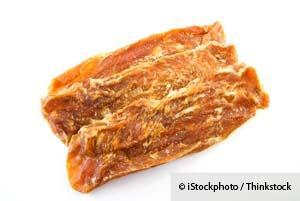For “Mammal Monday”:
Elected Officials Turn Up Heat on FDA's Handling of "Death Treats"

“One of the only ways a pet owner might learn about potentially deadly dog or cat treats is to visit the FDA website and look for pet food-related advisories. That's one of the reasons why, after five years and over 2,000 reported incidents of illness and death, unwitting consumers are still offering potentially deadly treats to their pets.
Recently, political leaders have become increasingly vocal in demanding the FDA do more to protect the health and lives of pets.
Unfortunately, with potentially deadly jerky pet treats still readily available on store shelves, word of mouth is one of the few options available to spread the news. Pet owners should avoid all treats containing ingredients from China - and any treat they aren't sure is entirely safe to feed their dog or cat.” Complete article at: http://healthypets.mercola.com/sites/healthypets/archive/2012/11/07/fda-pet-food-warning.aspx?e_cid=20121107_PetsNL_art_3
 More at: Chicken Jerky Treat Casualties: 360 Dogs, 1 Cat
More at: Chicken Jerky Treat Casualties: 360 Dogs, 1 Cat
_______
Anti-Aging Exercises to Keep Your Senior Pet Active

“Pets, just like their humans, need to stay active as they get up in years.
Your pet’s aging body will lose muscle tone, balance and fluid movement without regular exercise and healing therapies like massage.
Three groups of exercises that help senior pets stay active and pain-free include passive range-of-motion exercises, balance and movement exercises, and exercises that maintain large muscle groups like the hamstrings and glutes.
Massage can also be very beneficial to maintain flexibility and movement, as well as to ease sore muscles and joints.
There are lots of other things pet owners can do to help their older dog or cat age comfortably and in good health.” Complete article at: http://healthypets.mercola.com/sites/healthypets/archive/2012/01/26/anti-aging-exercises-for-pets.aspx
_______
“Urgent: Tell Congress to Stop the Cruelty 
One of the top priorities for the Humane Society Legislative Fund (HSLF) this year was to expose Rep. Steve King’s dreadful animal protection record—most notably his defense of the barbaric “sport” of animal fighting. Thanks to you, animal issues became a key part of the debate in his congressional race and around the country.
Now, we have an opportunity to strengthen penalties for animal fighting spectators nationwide and to give law enforcement the tools they need to crack down on animal fighting. But, we must tell Congress to act on this important legislation NOW, before they adjourn for the year.
The Animal Fighting Spectator Prohibition Act (S. 1947/HR. 2492) fixes a major gap in federal law and would prohibit knowing attendance at organized dogfighting and cockfighting events and impose additional penalties for bringing a child to an animal fight.
Over the past decade, Congress has strengthened the penalties for and closed major loopholes in the federal animal fighting law, but has left the issue of spectators unaddressed. Without penalties for spectators who attend and help finance these fights, we’ll never be able to end this barbaric practice for good.” From: http://action.humanesociety.org/site/MessageViewer?em_id=50986.0&dlv_id=53782 More at: https://secure.humanesociety.org/site/Advocacy?cmd=display&page=UserAction&id=5793
_______
Separation Anxiety
“Separation problems are very common with dogs. Dogs are highly social
animals and some have a difficult time being left alone.
Separation problems can result in housetraining issues, chewing and
destructive behaviors, barking, digging and anxiety.
If your dog is having a separation problem--the following are some steps
you can take to help him overcome it:
Step #1: Understand your dog's behavior.
Your dog is not destroying your house to spite or get back at you.
Step #2: Your dog is highly stressed and cannot handle being by herself. You need to help your dog feel secure when left alone.
Step #3: Help develop your dog's tolerance for being left alone. Your dog becomes stressed when you leave.
Step #4: To increase your dog's stress tolerance, you need to gradually leave your dog alone for longer and longer periods.
Step #5: This is accomplished by putting on your jacket, grabbing your keys like you're leaving and walking out the door.
Step #6: Once you're outside, wait about 5 minutes and walk back in.
Step #7: If your dog can handle the 5 minutes, increase the time to 10 minutes. Once your dog can handle the 10 minutes, keep gradually
increasing the amount of time you're outside. This does require some time and patience.
Step #8: Crate training your dog can also be very helpful when you have to leave for longer periods of time.
Step #9: Exercise your dog. A dog that has separation problems and a lot of pent-up energy will result in disaster.
Step #10: Bringing your dog to a dog daycare may be an option if your dog does not like the crate and if your dog is very active.
Step #11: The exercise and mental stimulation at the daycare should help your dog overcome separation anxiety.
Step# 12: In extreme cases you may need the help of your veterinarian. A vet can provide medication for dogs that are extremely stressed when left alone. Get more help with separation anxiety at the
Dog Training Inner Circle where I can answer your questions personally.
http://dogtraininginnercircle.com All the best, Eric” From: http://dogtraininginnercircle.com/element.php?varset=s:438-pm:p-se:19411-e:45645&SessId=
_________
Moving? How to Minimize Dog and Cat Stress

iStockphoto
“Moving is tough on families, and it's particularly stressful on dogs and cats. Animals always know when something's amiss, even if they can't understand exactly what's changing or why.
The key to moving pets is to keep them secure before and during the move and to settle them safely and quickly into a routine afterward.
The family dog is a bit easier to deal with. Put his leash on and drive him to his new address. Show him his new, warm home and the securely fenced backyard. Unless the dog is a high-jumper of Olympic caliber, he'll stay put while he adjusts.
Cats are a particular worry at moving time. They not only form a bond with the people in a home, but they are also attached to the home itself. Because of their mobility, cats can be difficult to keep around the new home long enough for them to realize that this is where the people they love now live.
Once they're moved, free-roaming cats often try to flee to their familiar dwelling. The cases of cats returning to their previous homes are common for people who move short distances, and the instances of cats disappearing forever are just as common for families moving great distances.
Confinement is essential when moving cats. It keeps them safe while they become used to their new territory and make it their own. If your cat isn't already an indoor cat, bring him inside before the movers arrive. Set him up in a "safe room" — a spare bathroom or bedroom is ideal — and leave him alone. Provide him with food and water, his bed, a scratching post, a litterbox and a couple of favorite toys while the packing and moving is under way.
The cat's ride to the new home is best undertaken in a carrier, especially for the cat who rarely sees the inside of a car.
At the new home, work the "leaving home" procedure in reverse. Put the cat into a "safe room" for a few days — until the movers are gone, the furniture arranged and most of the dust settled — and then allow him to explore inside the house on his own terms after things calm down a bit.
Quickly re-establish a routine. Pick a time and a place for feeding, and stick to it for all pets.
If you've been thinking about converting your free-roaming cat into a house dweller for his health and safety, moving to a new home is the perfect time to accomplish it. In your old home, you'd be constantly listening to your cat demanding to be let out into the rest of his territory. In a new home, he hasn't established any territory of his own yet, and you can make the new home his only turf by keeping him inside from day one.” More at: http://www.vetstreet.com/our-pet-experts/moving-how-to-minimize-dog-and-cat-stress
_________
Study Finds Free-Roaming Cats Pose Threat from "Serious Public Health Diseases"
Among the key findings of the paper are:
- Free roaming cats are an important source of animal-transmitted, serious diseases such as rabies, toxoplasmosis, and plague.
- Free roaming cats account for the most cases of human rabies exposure among domestic animals, and are the source for one-third of rabies post-exposure treatments in the United States. Because of inconsistent incident reporting, that number is likely an underestimate of the actual cases of rabies exposure.
- Trap, neuter, and release (TNR) programs may lead to increased, un-inoculated populations of cats that can serve as a source of transmittable serious diseases.
The study found that since 1988, rabies has been detected more frequently in cats than in dogs; in 2008, the number of cats detected with rabies was four times higher than dogs. In 2010, rabies cases declined for all domestic animals except cats, which comprised 62 percent of all rabies cases for domestic animals.
“This is a significant study that documents serious wildlife and public health issues associated with 125 million outdoor cats in the United States. Decision-making officials need to start looking at the unintended impacts these animals have on both the environment and human health when they consider arguments to sanction Trap, Neuter, and Return (TNR) cat colonies. These colonies are highly detrimental to cats, wildlife, and people, and only serve to exacerbate the cat overpopulation problem,” said Darin Schroeder, Vice President for Conservation Advocacy at American Bird Conservancy.” More at: http://www.abcbirds.org/newsandreports/releases/120918.html
________
Patrick The Miracle Dog Survives Abuse In Newark, NJ.
“A dog that was found near death in New Jersey has been nursed back to life. The dog had barely any skin over its bones when someone tossed it down a trash chute in Newark. The lucky dog they are calling “Patrick the miracle dog” is recovering.
“According to the Los Angeles Times, Kisha Curtis, the dog's 27-year-old owner, had tied him to a railing and left him there for a week. It's unclear if she threw him down the chute or if someone else did.
Patrick was then taken in and cared for by the Associated Humane Societies in New Jersey, reported ohmidog.com Volunteers took him to Garden State Veterinary Services where a giant hairball was removed from his stomach so that he could begin to eat again. The Vets think it could be something he eat out of desperation while nearly starving to death. "The veterinary staff immediately put him on intravenous fluid. His temperature was so low that it did not even register on the thermometer," says Patrick's Facebook page. He soon became an Internet celebrity, with donations pouring in from around the world.
Patrick weighed 19 pounds when he arrived at the hospital. He now weighs 50 pounds. Associated Humane Societies is seeking custody of Patrick, whose newfound fame is being used to advocate for stricter animal abuse laws. AHS wants to find a new forever-home for Patrick. Garden State Veterinary Specialists of Tinton Falls, however, is also vying for a part in Patrick's plight. He has been staying with Patricia Smillie-Scavelli, the hospital’s administrator, who also wants to keep the brave dog.
“He really gives love,” Scavelli told Irish Central. “He climbs into your lap, he would prefer to sit in your lap than lay on the floor. He also sleeps in our bed at night, along with the cat.”
However, a few physical scars remain from Patrick's ordeal. NBC reports that he is still fearful of strangers, but when fed a few dog treats, he quickly warms up.
Curtis is scheduled to appear in court on charges of animal cruelty. She is not accused with tossing Patrick down the chute, only with neglect and abandonment.” Patrick, The Miracle Dog, Recovers After Being Starved, Tossed Down Garbage Chute (PHOTOS)
Update: http://www.huffingtonpost.com/2012/09/18/patrick-the-miracle-dog-_n_1894325.html
See Patrick Play:
________
Dog Welcomes Home Sailor after 7 months in Afghanistan!!!
“Bailey Welcomes home Sean after 7 months. I was surprised she still remembered me, we got her at the pound as a stray only 3 months before I left!”
________
Help Shelters and Rescued Animals On The East Coast Recover!
Click Here
and make your click
to fund food, FREE.
http://www.theanimalrescuesite.com/clickToGive/home.faces?siteId=3&ThirdPartyClicks=ERA_090309_ARS
_________
On This Day:
The Great Diamond Hoax is exposed, Nov 26, 1872:
“The Great Diamond Hoax, one of the most notorious mining swindles of the time, is exposed with an article in the San Francisco Evening Bulletin.
Fraudulent gold and silver mines were common in the years following the California Gold Rush of 1849. Swindlers fooled many eager greenhorns by "salting" worthless mines with particles of gold dust to make them appear mineral-rich. However, few con men were as daring as Kentucky cousins Philip Arnold and John Slack, who convinced San Francisco capitalists to invest in a worthless mine in the northwestern corner of Colorado.
Arnold and Slack played their con perfectly. They arrived in San Francisco in 1872 and tried to deposit a bag of uncut diamonds at a bank. When questioned, the two men quickly disappeared, acting as if they were reluctant to talk about their discovery. Intrigued, a bank director named William Ralston tracked down the men. Assuming he was dealing with unsophisticated country bumpkins, he set out to take control of the diamond mine. The two cousins agreed to take a blindfolded mining expert to the site; the expert returned to report that the mine was indeed rich with diamonds and rubies.
Joining forces with a number of other prominent San Francisco financiers, Ralston formed the New York Mining and Commercial Company, capitalized at $10 million, and began selling stock to eager investors. As a show of good faith, Arnold and Slack received about $600,000-small change in comparison to the supposed value of the diamond mine. Convinced that the American West must have many other major deposits of diamonds, at least 25 other diamond exploration companies formed in the subsequent months.
Clarence King, the then-little-known young leader of a geographical survey of the 40th parallel, finally exposed the cousins' diamond mine as a hoax. A brilliant geologist and mining engineer, King was suspicious of the mine from the start. He correctly deduced the location of the supposed mine, raced off to investigate, and soon realized that the swindlers had salted the mine--some of the gems he found even showed jewelers-cut marks.
Back in San Francisco, King exposed the fraud in the newspapers and the Great Diamond Hoax collapsed. Ralston returned $80,000 to each of his investors, but he was never able to recover the $600,000 given to the two cousins. Arnold lived out the few remaining years of his life in luxury in Kentucky before dying of pneumonia in 1878. Slack apparently squandered his share of the money, for he was last reported working as a coffin maker in New Mexico. King's role in exposing the fraud brought him national recognition--he became the first director of the United States Geological Survey.”
_________
First U.S. "cloverleaf" appears on the cover of the Engineering News-Record, Nov 26, 1931:

These circular ramps move cars from one road to the other fairly efficiently, as long as the roads aren't too busy—but once traffic speed and volume increases, cloverleaves can be just as dangerous as the intersections they replaced. The Woodbridge interchange, for instance, had no merge lanes, so it forced motorists to stop without warning or to plunge directly into highway traffic. Many thousands of fender-benders were the result. It was "the Model T of cloverleafs," said a spokesman for the New Jersey Department of Transportation (NJDOT). "It worked well at one time, but it's beginning to reach the end of its usefulness." As a result, it's getting a facelift: the NJDOT plans to replace the sprawling cloverleaf with a more compact, diamond-style interchange that will eliminate both the dangerous merges and the associated gridlock.”
_______
FDR establishes modern Thanksgiving holiday, Nov 26, 1941:
“President Franklin D. Roosevelt signs a bill officially establishing the fourth Thursday in November as Thanksgiving Day.
The tradition of celebrating the holiday on Thursday dates back to the early history of the Plymouth and Massachusetts Bay colonies, when post-harvest holidays were celebrated on the weekday regularly set aside as "Lecture Day," a midweek church meeting where topical sermons were presented. A famous Thanksgiving observance occurred in the autumn of 1621, when Plymouth governor William Bradford invited local Indians to join the Pilgrims in a three-day festival held in gratitude for the bounty of the season.
Thanksgiving became an annual custom throughout New England in the 17th century, and in 1777 the Continental Congress declared the first national American Thanksgiving following the Patriot victory at Saratoga. In 1789, President George Washington became the first president to proclaim a Thanksgiving holiday, when, at the request of Congress, he proclaimed November 26, a Tuesday, as a day of national thanksgiving for the U.S. Constitution. However, it was not until 1863, when President Abraham Lincoln declared Thanksgiving to fall on the last Thursday of November, that the modern holiday was celebrated nationally.
With a few deviations, Lincoln's precedent was followed annually by every subsequent president--until 1939. In 1939, Franklin D. Roosevelt departed from tradition by declaring November 23, the next to last Thursday that year, as Thanksgiving Day. Considerable controversy surrounded this deviation, and some Americans refused to honor Roosevelt's declaration. For the next two years, Roosevelt repeated the unpopular proclamation, but on November 26, 1941, he admitted his mistake and signed a bill into law officially making the fourth Thursday in November the national holiday of Thanksgiving Day.”
_______
Yesterday:

Except for Miss Priss that is!
She just tore around until she fell asleep on the porch!
She would rather chase around than eat!
It started out cold, and Misty had to wear her other coat, not her raincoat this time, to keep warm.
Then I made some turkey in gravy from the dark meat from the carcass. The broth is already strained out, but there was still a lot of meat left. The white meat and broth have already been frozen. That is a fiddly job, making sure all the tiny bones are discarded, and I still don’t have all the dark meat sorted through. I don’t know if it is worth it. I wonder how they do it in the Chinese restaurants. Maybe they have a ‘bone magnet’!
They must do it when it is still raw, so much easier:
I should have been outside raking up the Red Maple’s leaves, as it warmed up to a lovely day.






















2 comments:
I always made sure any foods and treats I bought for my dog were made in the USA. The packages are marked with a small US flag near the name of the mfr. Also, if it's certified organic you can trust that it's good
Thank you for your comment, Gypsy.
I, too, am very fussy about what Misty eats, and I make sure she doesn't eat any of the junk food sold in the grocery stores. Feeding her only organic food seems to be paying off, and it's cheaper than vet bills.
My Misty is now 17-1/2 years old, and I hope to keep her spry and healthy for as many years as I can.
Happy Trails, Penny
Post a Comment